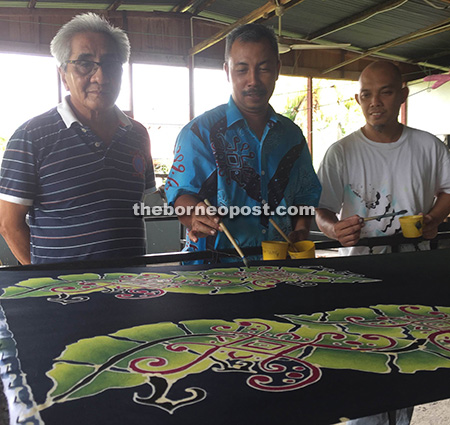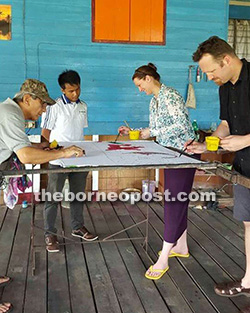
Rothman (left) with an officer from the Prisons Department (centre) taking a private course, monitored by one of his assistants.
FROM learning the techniques of making batik in Kelantan and Terengganu to becoming a pioneer of Sabahan batik painting, Rothman Buntar has come a long way.
It took him 27 years to be where he is today.
Now at 67, the Tuaran-born entrepreneur is still making batik and has been continuously receiving orders from domestic and international customers.
The Dusun Lotud native believes that he has been gifted by the creator with his talent in making batik and feels responsible to pass down the knowledge to those who are interested.
Rothman Batik, his factory in Kampung Marabahai Tuaran, not only produces batik but also offers batik making courses to young enthusiasts, artists, lecturers, foreigners and trainers from government agencies.
He remembers vividly how his company started with a humble beginning.
“Rothman Batik was born in a rented room in Sinsuran, Kota Kinabalu in 1989.
“The small room was my nest. My wife and I sleep, eat and do batik there.
“Batik is my passion. When I was in Kuala Lumpur in 1981 to start my workshop business, my interest converted into batik. I feel connected to batik. At that time, Kelantan and Terengganu were the biggest names in the field. I decided to go there, to learn from them. Unfortunately, there was no room for an outsider like me to learn.
“I did not give up, because I really wanted to learn how to make batik. I came up with a fake letter, saying that I was a student from a local university doing research on batik,” he said giggling.
He knew it was wrong, but his curiosity made him do it. His letter made him a ‘researcher’ for three days.
Using the letter, he went to a number of batik factories in Kelantan and Terengganu to learn the basics of making batik – the rest is history.

A private lesson for an international tourist.
His love for batik led him to learn from other factories in Kedah, Perak, Ampang and Gombak – which were easier for him to get access to.
“After learning the basics, I bought my own tools and started practising.
“When talents come alive, you will find yourself a greater person by far more than you ever dreamed yourself to be,” said Rothman.
Over a period of almost three decades making batik in Sabah, Rothman discovered various techniques in producing unique batik.
Currently, he is using 16 techniques.
Some of the techniques are not even used by the batik makers in the peninsular.
“When I first started making batik in the 20 sq ft room in Sinsuran, everything was hand-drawn. My first customer was an engineer from the company I worked for at the time – Lembaga Letrik Sabah (Sabah Electricity).
“When I introduced my art works to my friends, they were not encouraging because to them, only Kelantan and Terengganu can produce batik. The engineer was the only one who had faith in me,” he recalled.
Rothman said his profit from a two-metre piece of batik was around RM20 because materials for colouring were not available in Sabah. He had to get them from Kuala Lumpur.
Not long after the engineer ordered his batik, the club members of Lembaga Letrik asked him to make 40 pieces of batik for their annual dinner.
It was followed by a 50-piece order from Sandakan Forestry Department, all silk.
Until today, Rothman Batik has always been making batik for government agencies and private entities including VVIPs.
His technique is still the traditional method such as tjanting and block, but he has improvised on some techniques of colouring, for example using air brush to make sure the colour is even.
“Looking back at the potential 27 years ago, my wife and I worked around the clock to make sure all orders were perfect and delivered on time.
“We decided to rent a bungalow in Luyang at the end of 1989 for a bigger space. Orders were increasing and I finally hired two workers in 1993 to help with the colouring.
“People are always looking for me because my designs are exclusive. Every customer will have a totally different design. Everything is based on what they want. The best part is, we charge a reasonable price.
“I never limit my designs because we are blessed with inspirations from the deepest sea, to the highest sky,” he added.
With over 6,000 motifs designed for his customers and his wide experience in developing young talent in Sabah, Rothman is among batik makers in Malaysia awarded the Diploma certificate by the Department of skills Development Malaysia under the skills certification system.
In 2010, Rothman was awarded the Myskills 2010 Kebangsaan – Gold, the highest skills certification award in Malaysia.
As the pioneer of batik making in Sabah, Rothman Batik is the only batik centre offering courses which are recognized by the government.
Having experience in various techniques in making unique batik and the ability to create his own colours from natural resources is one of the reasons his batik is accepted worldwide.
Rothman Batik is engaged with batik entrepreneurs from the Philippines, Japan, England and the US.
However, there is no business without challenges.
But to Rothman, bad times have their own value. These are occasions a good learner would not miss.
“When we first started, the main challenge was to get licence from the local authority. There are some issues about the colouring. They said the colour was not good for my health.
“After I questioned why batik makers in the peninsular could obtain their licences easily, they could not answer me and I finally got my licence. That is the challenge – to change the system more than it changes you,” said Rothman who conversed mainly in English and Malay.
Today, the challenges are more on economic stability.
When the economy is good, people would spend more. But how to survive if the demand is not high?
To Rothman, a businessman should be ready for any situation – good or bad.
“I like the challenge of trying different things and wondering whether it is going to work or not as long as batik making is kept alive.
“When I cannot depend on local customers, I will push my international market. There are times when I come up with crazy ideas.
“When the meteor shower happened a few years ago, I made money from it because of my meteor motif. When the tsunami incident killed thousands of people, I made money from my Tsunami Killer motif,” Rothman explained excitedly.
He believes that batik is always relevant and a tradition.
To him, batik should be protected and not be seen as an expensive fashion but an art and tradition.
When batik is seen as an expensive fashion, there will be people taking advantage of making it ‘affordable’ by offering cheap material, just to fit into the business scene.
Rothman’s reaction changed after he was asked about digital printing.
thesundaypost interviewed Rothman at his factory recently, when he was having a private course with an officer from the prisons department.
“Batik is the art medium that best represents Malaysia. When you talk about batik, everything is about making it manually.
“That is the real art. There is no shot-cut in art.
“When you talk about digital printing, that is not batik. It is just colour on a fabric, and it cannot be included into the craft category because there is no effort in making it alive,” Rothman opined.
Batik digital printing, said Rothman is not a new thing in the market as it was done by a number of businessmen in the peninsular in the 1990s.
Digital printing is cheap and easy, but the exclusivity was not there anymore as it can be printed hundreds of times.
“People who appreciate and respect batik will always go for the real thing, and not the copy because there is pride in it.
“I only hope that the younger generation will continue to learn batik so that Sabahans can have it easily without going to the peninsular to buy. I hope my children will continue my business, and hundreds of my former students will continue making batik.
“I can see my children are interested in the business but some of them have their own way of expressing art, especially my daughter Rozza who loves spending time in the factory whenever she can.
“There are more than 10 batik makers in Sabah, most of them are my former students,” he said.
Apart from locals, Rothman also accepts foreign students who came to learn batik at his factory at a reasonable charge.
